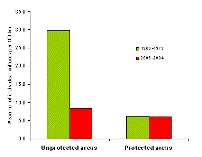
In Burkina Faso, Mali and Niger, survey data indicate that raptor species have an unfavourable conservation status outside of protected areas, to the extent that populations of large raptors (vultures, eagles) have suffered significant declines over the past 30 years and several vulture species have been re-classified as threatened on the IUCN Red List.

Protected areas play a prominent role in the maintenance of raptor populations, but in the areas outside them many raptor species have an unfavourable conservation status and many populations are declining (Thiollay 2006a, Thiollay 2007a, Thiollay 2007b). A survey of raptor distribution in Burkina Faso and surrounding countries (Mali, Niger) during the dry season of 2004–2005 highlighted a notable decline in raptor abundance with increasing distance from protected areas (see figure a). Large raptors exhibited the most marked differences in abundance with 12 species being recorded in protected areas, significantly fewer in peripheral areas and none in cultivated areas (Thiollay 2007a).
Further analysis based on dry season counts carried out in 1969–1973 and repeated in 2003–2004 revealed that 11 large eagle species had declined by 86–98% over the 30 year period outside protected areas. In addition, six large vulture species also suffered dramatic declines outside protected areas (Thiollay 2006a, Thiollay 2007b, see figure b), with some that were relatively common in the early survey disappearing entirely by 2004 (Thiollay 2006b). These studies have contributed to two vulture species being uplisted from the Least Concern category to Near Threatened (White-backed Vulture Gyps africanus and Rueppell’s Vulture G. rueppellii), one to Vulnerable (White-headed Vulture Trigonoceps occipitalis) and one to Endangered (Egyptian Vulture Neophron percnopterus) in the 2008 IUCN Red List (BirdLife International 2008).

Although no specific reason for the collapse in raptor populations in unprotected areas has been identified, the declines are almost certainly linked with rapid human population expansion and accompanying habitat degradation and ecosystem impoverishment (e.g. overgrazing, agricultural intensification, pollution) that have occurred over the past 30 years(Thiollay 2006a, Thiollay 2007a, Thiollay 2007b). The dramatic declines in vulture populations may also have been caused by reductions in major food resources as a result of the near-extinction of wild ungulates (antelopes, gazelles) through over-hunting, the intensified use of cattle, increased disturbance and the poisoning or contamination of carcasses(Thiollay 2006a, Thiollay 2006b, Thiollay 2007b; see also Thiollay 2006c).
Related Species
References
Compiled: 2008
Recommended Citation:
BirdLife International (2008)
West African raptors are faring poorly outside of protected areas.
Downloaded from https://datazone.birdlife.org/sowb/casestudy/west-african-raptors-are-faring-poorly-outside-of-protected-areas on 22/12/2024